I’ve spent a lot of time digging into what gay travelers really need to know before heading somewhere new. From safe, welcoming spots to the best local events, I’ve got a handle on the info that helps you feel comfortable and confident while exploring. Plus, with my background in travel writing, I know how to paint a picture that makes you feel like you’re already there, soaking up the culture and vibrant energy of a place like Oaxaca.
Oaxaca City is a place where history, vibrant colors, and authentic Mexican culture come together in an unforgettable way. From cobblestone streets and colonial architecture to mezcal tasting rooms and markets bursting with handmade crafts, there’s no doubt this city has a unique allure. But for gay travelers, there’s often a pressing question: Is Oaxaca City truly worth visiting?
In this guide, we’ll explore why Oaxaca is not only worth a trip but may also be one of the most gay friendly destinations in Mexico. Let’s dive into what makes Oaxaca City special and what gay visitors should know before going.
Table of Contents
ToggleWhy Oaxaca City Should Be on Every Gay Traveler’s List
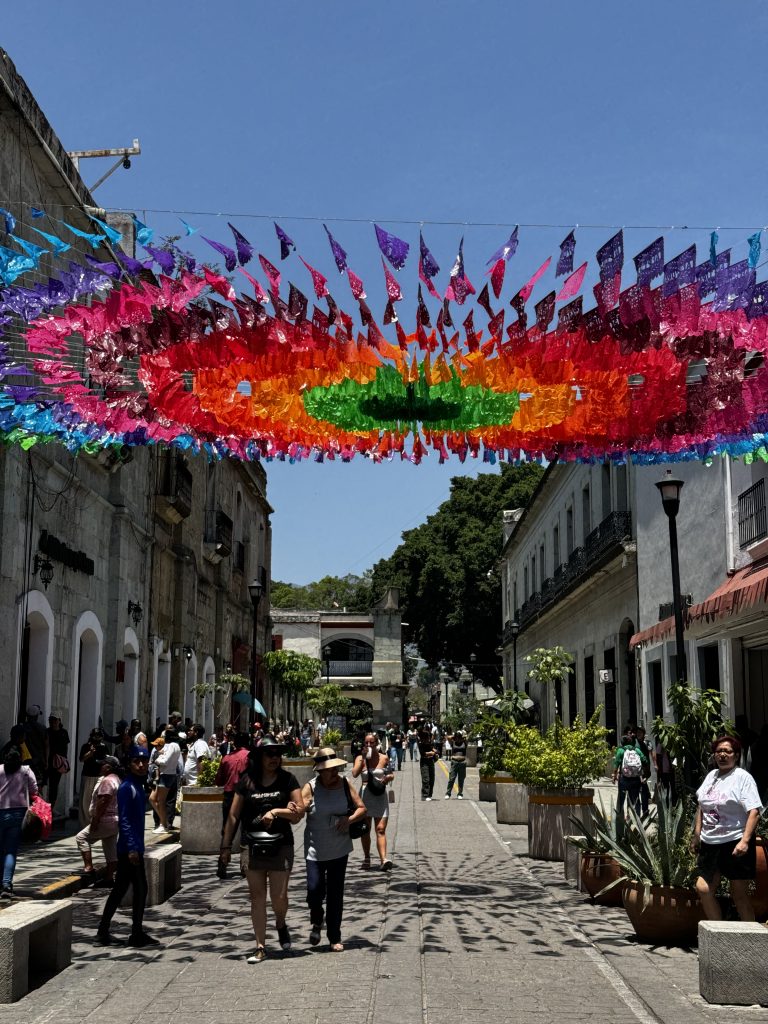
➡️ A Cultural Hotspot with a Relaxed Vibe
Oaxaca City is often described as a cultural capital, offering everything from art galleries and historical sites to vibrant fiestas and parades. Unlike some other Mexican cities that can feel a bit overwhelming, Oaxaca maintains a laid-back, welcoming atmosphere. This makes it ideal for travelers who want an immersive experience without the high-energy hustle of big tourist hotspots like Cancun or Mexico City.
➡️ A Growing LGBTQ+ Community
Oaxaca might not have a massive gay scene like Puerto Vallarta, but it’s surprisingly inclusive and accepting. The city is home to a small yet welcoming queer community, with spaces that openly cater to LGBTQ+ travelers. Local attitudes are generally open-minded, especially in the city center, which has seen an influx of international travelers and digital nomads.
➡️ Rich Indigenous Culture and Traditions
The state of Oaxaca has one of the most diverse Indigenous populations in Mexico, which influences everything from language and art to cuisine and festivals. The Indigenous heritage is celebrated rather than hidden, and this cultural pride resonates with gay travelers seeking authenticity and diversity.
Gay-Friendly Nightlife
➡️ Blue 69 Bar is a small hole in the wall gay bar. They serve strong drinks and the clientele is very friendly.
➡️ Club 502 is Oaxaca’s first gay club and disco and is the most popular nightclub for the city’s LGBTQ community. This is the spot to go for mixed drinks and great dance tunes.
➡️ La Selva de Los Gatos (The Cats’ Jungle): This bar has become a popular hangout spot for LGBTQ+ locals and visitors. Known for its relaxed vibe and welcoming environment, it’s a great place to start your night out.
Events and Festivals Gay Travelers Will Love

Oaxaca City is famed for its lively festivals, and many are particularly appealing to gay travelers. Here are a few must-attend events:
➡️ Dia de los Muertos (Day of the Dead): Held in late October and early November, Day of the Dead is celebrated on a grand scale in Oaxaca. The city is filled with colorful altars, parades, and celebrations, making it a mesmerizing experience for all visitors. For gay travelers, the festival’s focus on remembrance and acceptance resonates deeply, making it a meaningful event to attend.
➡️ Guelaguetza Festival: This traditional Indigenous festival takes place in July and features dance, music, and costumes from Oaxaca’s various Indigenous groups. The Guelaguetza is a vibrant celebration of Oaxaca’s cultural diversity, and it’s a unique opportunity to witness Indigenous pride and heritage.
➡️ Oaxaca Pride Parade: While smaller than in Mexico City, Oaxaca does host its own Pride event, typically in June. It’s an intimate yet spirited affair that brings together locals and visitors in celebration of LGBTQ+ pride. If you’re visiting during Pride month, it’s a wonderful way to experience Oaxaca’s inclusive side.
Is Oaxaca Safe for Gay Travelers?
Safety is always a priority, especially for gay travelers exploring new destinations. Generally, Oaxaca City is considered safe, with a lower crime rate than many other Mexican cities. Still, as with any travel, it’s essential to be aware of your surroundings and avoid isolated areas after dark.
Oaxaqueños (people from Oaxaca) are known for being friendly and welcoming. Most travelers report feeling comfortable, even as openly gay. However, while public displays of affection are generally accepted in tourist-heavy areas, it’s best to be discreet in more conservative spaces or rural areas outside the city.
Must-See Places in Oaxaca City
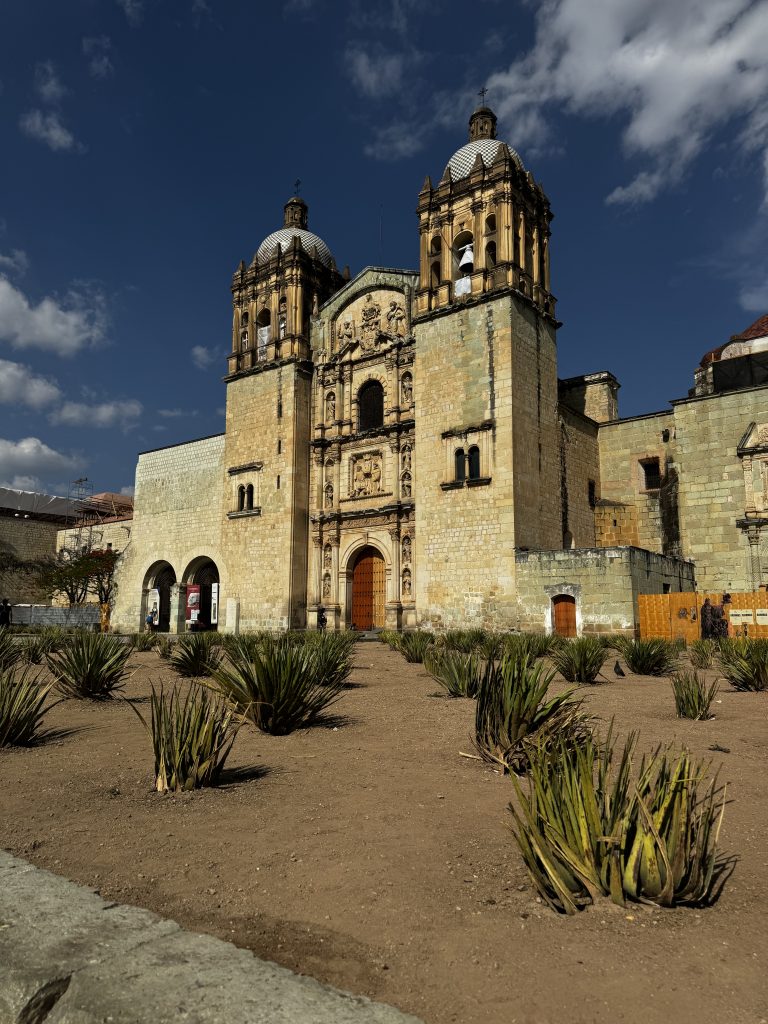
➡️ Zócalo (Main Square)
The Zócalo is the heartbeat of Oaxaca City. It’s the perfect spot to take in the local vibe, with street musicians, vendors, and plenty of benches for people-watching. Surrounded by colonial buildings and the Oaxaca Cathedral, the Zócalo is a must-see for any visitor.
➡️ Santo Domingo Church and Cultural Center
The Santo Domingo de Guzmán Church is a stunning example of Mexican Baroque architecture. Adjacent to the church is the Santo Domingo Cultural Center, where you can learn about Oaxaca’s rich history and view impressive art and historical artifacts.
➡️ Mercado Benito Juárez
For a taste of Oaxaca’s famous cuisine, head to Mercado Benito Juárez. This bustling market offers everything from mole (a traditional Oaxacan sauce) to chapulines (fried grasshoppers). The market is a sensory overload in the best way, and it’s a perfect spot to pick up unique souvenirs.
Oaxaca’s Botanical Garden, or Jardín Etnobotánico, is a lush oasis located right in the heart of the city, next to the historic Santo Domingo Church. It showcases a stunning variety of native Oaxacan plants, from towering cacti to rare agaves, all arranged to highlight the state’s diverse ecosystems. Guided tours are available, providing fascinating insights into the cultural significance and medicinal uses of these plants, making it a must-visit spot for nature lovers and curious travelers alike.
Oaxaca’s Culinary Scene: A Foodie Paradise
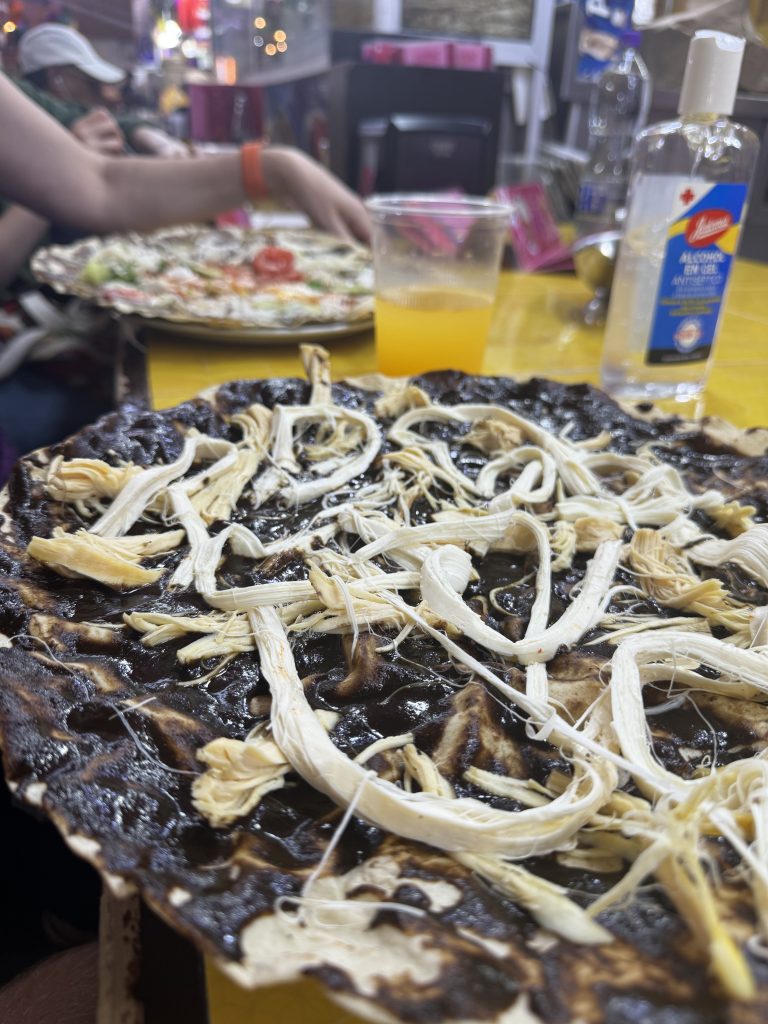
Oaxaca is known as the “Land of the Seven Moles,” but there’s far more to its culinary scene than its signature sauce. Here’s what gay travelers should try:
➡️ Tlayudas: Often called a “Mexican pizza,” this crispy tortilla is topped with beans, cheese, and meat (or veggies if you prefer). It’s the ultimate comfort food after a night out.
➡️ Mole: With seven varieties, mole is a complex, rich sauce made from ingredients like chili peppers, chocolate, and spices. Each mole has its unique flavor profile, making it worth sampling them all if you can.
➡️ Mezcal: Oaxaca’s Iconic Spirit
Mezcal is to Oaxaca what tequila is to Jalisco—only with a smokier, more complex flavor profile. Oaxaca is the heartland of mezcal production, and a visit wouldn’t be complete without trying this traditional agave-based spirit. Unlike tequila, mezcal can be made from various types of agave, which leads to a wide range of flavors. Here are a few ways to explore mezcal in Oaxaca City:
- Mezcal Tastings: Many bars and tasting rooms in Oaxaca City offer guided mezcal tastings. La Mezcalerita, Sabina Sabe, and El Destilado are a few gay-friendly spots where you can sample different mezcals and learn about the intricate distillation process.
- Mezcal Distillery Tours: For a deeper dive into the world of mezcal, consider taking a day trip to a local distillery. Places like Matatlán, known as the “World Capital of Mezcal,” offer tours where you can see the traditional, labor-intensive methods used to produce this artisanal spirit. Plus, most tours end with a tasting, giving you a chance to sip mezcal right where it’s made.
- Pairing Mezcal with Local Cuisine: Oaxaca’s chefs have mastered the art of pairing mezcal with food, bringing out the best in both. Look for tasting menus in places like Casa Oaxaca or Criollo, where chefs expertly match mezcal varieties with Oaxacan dishes.
Oaxaca’s Art Scene: A Creative Haven for Gay Visitors
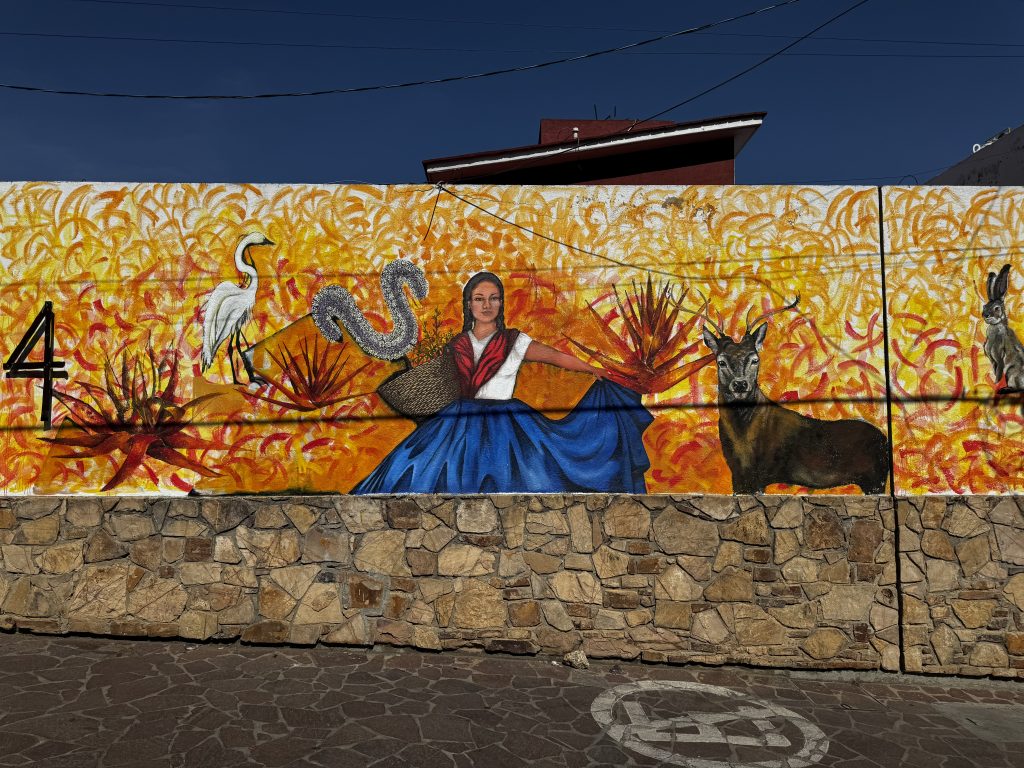
Oaxaca City has a thriving art scene, much of which is tied to its Indigenous roots and modern-day social movements. The city’s creativity and expression make it especially appealing for gay travelers interested in art and culture. Here are some must-see art spots in Oaxaca:
➡️ Museo de Arte Contemporáneo de Oaxaca (MACO): Located in a beautiful colonial building, MACO showcases contemporary Oaxacan and Mexican art. The exhibits often address social issues, including LGBTQ+ themes, making it a thought-provoking visit.
➡️ La Calera Gallery: This unique space is a blend of gallery, bar, and cultural center, and it regularly hosts events, live music, and exhibitions. The atmosphere is relaxed and inclusive, welcoming a diverse crowd, including many gay locals and travelers.
➡️ Street Art in Jalatlaco: The Jalatlaco neighborhood is famous for its colorful murals, many of which reflect Oaxaca’s political and social climate. You’ll see vibrant street art addressing themes like identity, love, and resistance—messages that resonate strongly with the LGBTQ+ community.
➡️ Textile Art at Museo Textil de Oaxaca: Oaxaca is a hub for traditional textile arts, and the Museo Textil de Oaxaca offers an in-depth look at the Indigenous weaving techniques that have been passed down for generations. The museum also highlights contemporary textile artists who are redefining this ancient craft.
Day Trips Around Oaxaca: Nature, History, and Adventure

One of the great things about Oaxaca City is its proximity to stunning landscapes, ancient ruins, and traditional villages. Here are some gay-friendly day trips that offer adventure, history, and a break from the city’s hustle and bustle.
➡️ Monte Albán: A UNESCO World Heritage site, Monte Albán is one of the most impressive ancient Zapotec ruins in Mexico. Only a short drive from Oaxaca City, this archeological site offers breathtaking views and an opportunity to explore pre-Hispanic history. Gay travelers with an interest in Indigenous history will find Monte Albán awe-inspiring and educational.
➡️ Mitla: Known for its intricate stone mosaics, Mitla is another important archeological site, located about 40 minutes from Oaxaca City. It has a more intimate feel than Monte Albán, and the surrounding town is a great place to learn about traditional crafts and weaving techniques. Consider booking a tour that includes both Mitla and nearby mezcal distilleries for a full-day experience.
➡️ Hierve el Agua: These petrified waterfalls and natural mineral pools are located in the mountains, about 1.5 hours from Oaxaca City. It’s an incredible spot to relax, swim, and take photos with views over the mountains. Many gay travelers enjoy Hierve el Agua because it offers a serene environment for relaxation and reflection. Note that the pools can get crowded, so arriving early is recommended.
➡️ Teotitlán del Valle: This charming village is known for its traditional weaving techniques and handcrafted textiles. Teotitlán del Valle is home to Zapotec families who create beautiful rugs and tapestries using natural dyes. Many gay travelers find a connection here with Indigenous artistry and traditions. A guided tour can provide a better understanding of the weaving techniques and cultural importance of textile art in Oaxaca.
Gay-Friendly hotels
Finding gay-friendly accommodation can be key to a comfortable and welcoming experience. Here are some top-rated options in Oaxaca City where gay travelers are celebrated and embraced:
This boutique hotel in the heart of Oaxaca City is known for its minimalist, stylish decor and inclusive vibe. Hotel Sin Nombre is gay-friendly and offers a unique stay with beautiful design, a rooftop pool, and an in-house mezcal bar.
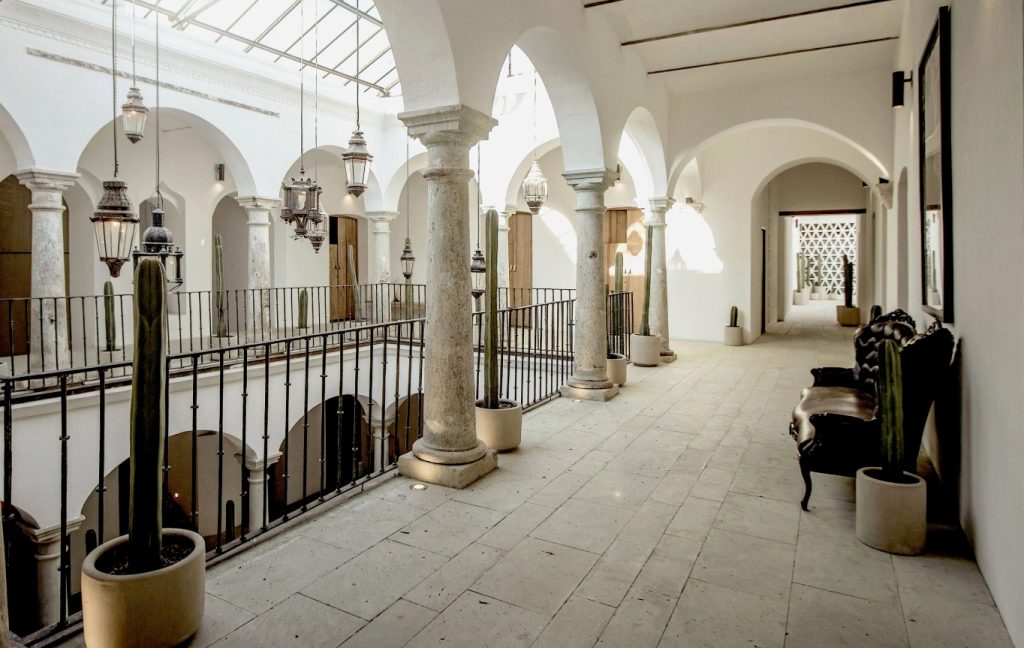
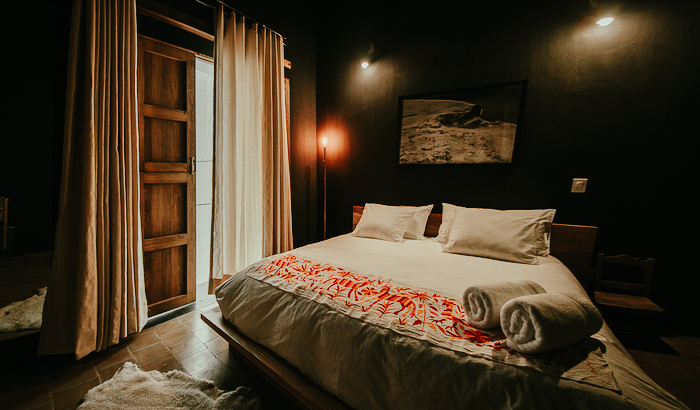
Located close to Santo Domingo Church, Casa de las Bugambilias is a charming bed-and-breakfast with a warm, welcoming atmosphere. The owners are known for being LGBTQ+ inclusive, and the beautifully decorated rooms and communal breakfast experience make it feel like a home away from home.
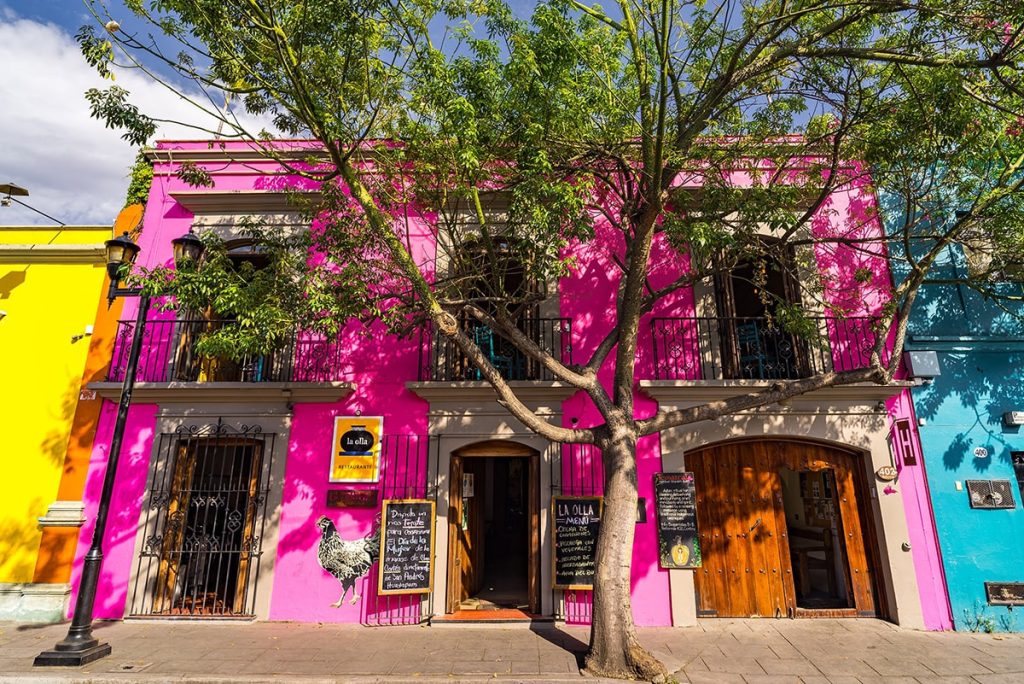
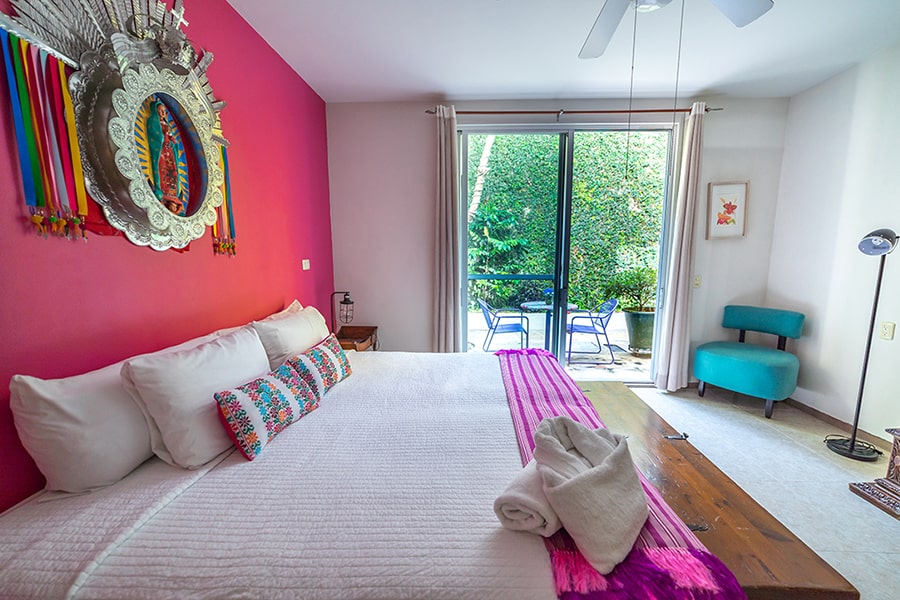
This popular hotel/hostel chain attracts a young, international crowd, including gay travelers. With its colorful decor, social vibe, and community events, Selina Oaxaca is an affordable and fun option for solo travelers or groups of friends.
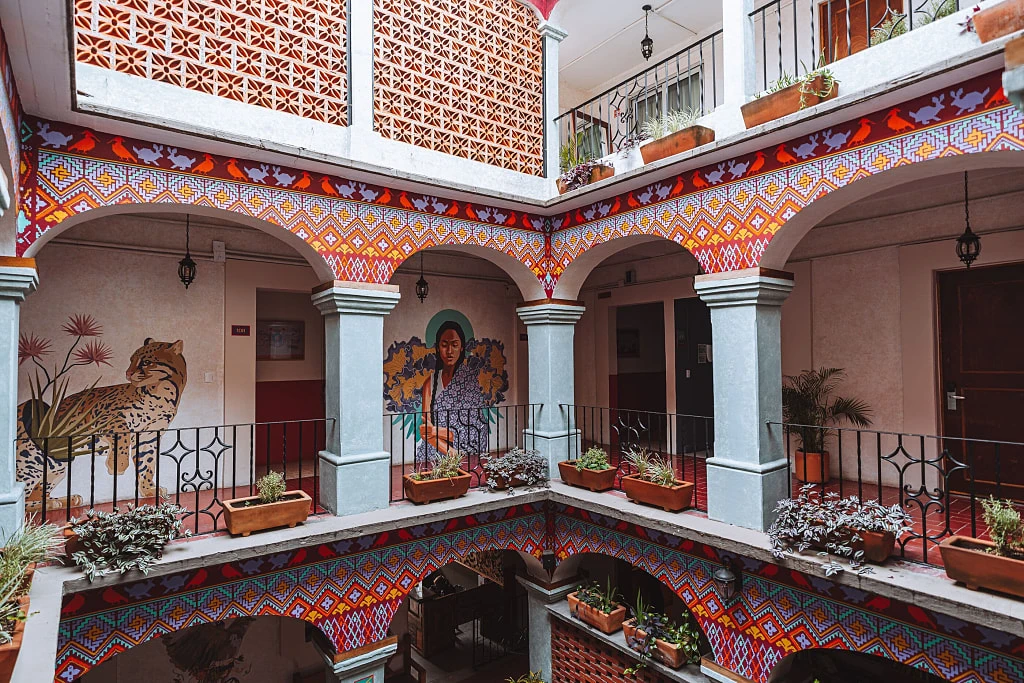
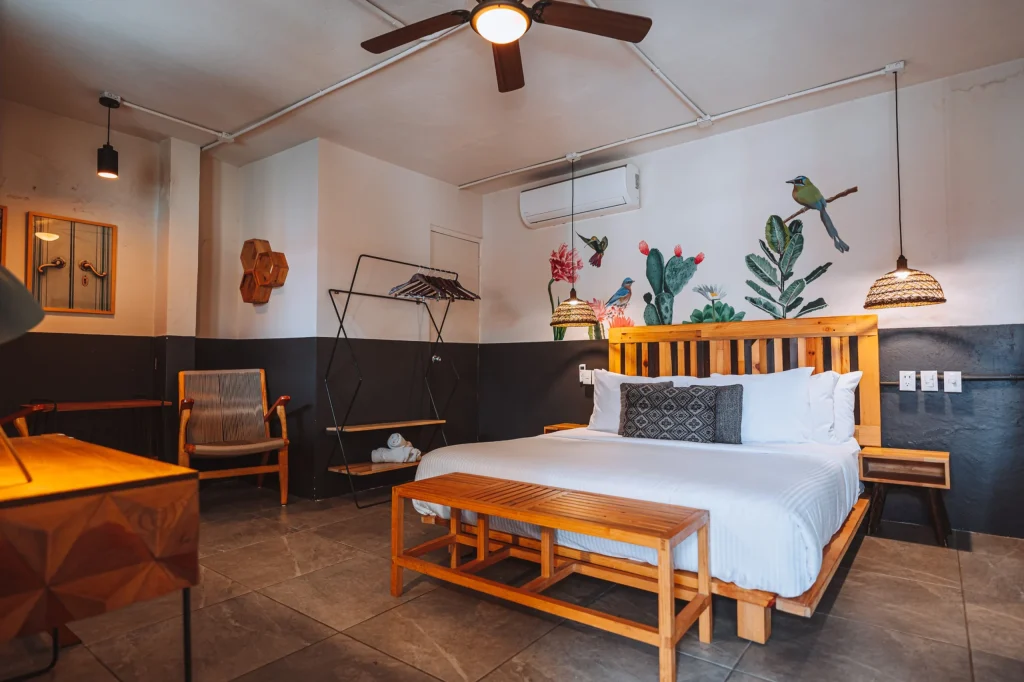
FAQS
How do I get to Oaxaca City?
You can reach Oaxaca City by flying directly into Xoxocotlán International Airport (OAX), which has connections to major cities in Mexico such as Mexico City, Guadalajara, and Monterrey, as well as some direct flights from the United States. Alternatively, you can take a bus from Mexico City, which takes around 6-7 hours.
How do I get from the Oaxaca airport to the city center?
The Oaxaca airport is about a 20-30 minute drive from the city center. You have a few options:
- Airport Shuttle Vans: These shared vans are economical, costing around 90-120 MXN (approximately $5-7 USD). You can find them right outside the terminal and they drop off passengers at various hotels in the city.
- Taxis: Official taxis are available at the airport and typically cost 200-300 MXN (around $10-15 USD) for a one-way ride to the city center. You can pay at the taxi counter in the airport and get a voucher.
- Private Transfers: If you prefer convenience, you can book a private transfer in advance, which may cost a bit more but ensures a direct ride to your accommodation.
What’s the best way to get around in Oaxaca City?
Oaxaca City is very walkable, especially in the city center where most attractions, restaurants, and nightlife spots are located. However, if you need to travel further:
- Taxis: Taxis are widely available and generally safe. Make sure to agree on the fare beforehand, as most taxis don’t have meters.
- Public Buses: The city has an affordable public bus system, though routes can be challenging to navigate without some basic Spanish.
- Ride-Sharing Apps: Currently, apps like Uber and Lyft are not operational in Oaxaca, but DiDi is an available ride-sharing app that works in the city.
- Bicycles: Several hotels and hostels rent bikes, which can be a fun and eco-friendly way to explore the city.
Is Oaxaca City safe for gay travelers?
Yes, Oaxaca City is generally safe for gay travelers. The city center and popular tourist areas are welcoming and accepting. However, as with any destination, it’s wise to stay aware of your surroundings and be mindful of local customs, particularly in rural or more traditional areas.
Can I find gay-friendly nightlife in Oaxaca City?
While Oaxaca doesn’t have a large gay nightlife scene, there are several inclusive bars and cafes. Spots like La Selva de Los Gatos and La Mezcalerita are popular with the LGBTQ+ community and offer a welcoming environment.
How can I meet other gay travelers in Oaxaca City?
Joining gay travel groups on social media, attending cultural events, and visiting popular gay-friendly bars are great ways to meet fellow travelers. Apps like Tinder and Grindr can also help you connect with locals, though always take precautions when meeting new people.
Are there guided tours gay travelers can join in Oaxaca?
Absolutely! There are several guided tours in Oaxaca City and surrounding areas that are welcoming to gay travelers. Options include food and mezcal tours, art and textile tours, and day trips to nearby ruins and natural sites like Hierve el Agua and Monte Albán. For LGBTQ+-specific or small group tours, consider reaching out to local tour operators who can offer personalized or private tours to suit your interests and comfort level.
Do I need to carry cash in Oaxaca City?
Yes, it’s a good idea to have some cash on hand in Oaxaca, as many smaller businesses, markets, and taxis may only accept cash. ATMs are available throughout the city center, but keep in mind that some may charge fees for international cards. Most mid-range and high-end restaurants, hotels, and larger stores accept credit cards.
When is the best time to go to Oaxaca City?
The best time to visit Oaxaca City depends on what you’re looking for in your trip. Here are some key periods to consider:
- October to November (Día de los Muertos): Late October to early November is one of the most popular times to visit Oaxaca, as the city comes alive with colorful Día de los Muertos (Day of the Dead) celebrations. This culturally rich holiday includes elaborate altars, parades, and festivities, offering a unique and unforgettable experience.
- July (Guelaguetza Festival): Held in late July, the Guelaguetza Festival is a celebration of Indigenous culture and dance, with performances by communities from across the state. It’s an excellent time to experience Oaxaca’s traditional arts, though it can be crowded and accommodations fill up quickly.
- December to February: This is Oaxaca’s dry season, which brings cooler temperatures and little rain, making it ideal for sightseeing and outdoor activities. It’s a great time for exploring Oaxaca’s ruins, markets, and natural sites without the risk of heavy rains.
- June (Oaxaca Pride): Although smaller than in Mexico City, Oaxaca’s Pride celebrations usually occur in June. If you want to show your support and celebrate with the local LGBTQ+ community, this is a wonderful time to visit.
- Avoid the Rainy Season (June to September): While the rain doesn’t usually disrupt activities in the city, the months of June through September can see heavy showers, especially in the afternoons. However, prices for flights and accommodations are often lower during this period, so it can be a budget-friendly option.
FINAL THOUGHTS
In a word: absolutely. Oaxaca City is more than just a beautiful Mexican city; it’s a place that celebrates diversity, art, and culture in a way that resonates deeply with gay travelers. From its inclusive spaces and welcoming locals to its rich history and vibrant arts scene, Oaxaca offers an experience that’s both unique and deeply moving.
While it might not have the extensive LGBTQ+ infrastructure of other destinations, its charm lies in its authenticity, respect for Indigenous traditions, and warm acceptance. Whether you’re there to explore ancient ruins, dive into Oaxaca’s legendary culinary scene, or simply wander the colorful streets with new friends, Oaxaca City is a place where you’ll feel welcomed and inspired.
About the Author
Tim is a seasoned gay travel writer and the creator of Out in Mexico, a dedicated resource for gay travelers exploring Mexico’s vibrant destinations. After relocating to Guadalajara, he has spent years immersing himself in Mexico’s gay culture, from the iconic beaches of Puerto Vallarta to the nightlife of Mexico City.
With firsthand experience in Mexico’s gay scene, Tim has personally visited the bars, hotels, and events featured in this guide. His insights have helped gay travelers plan unforgettable trips while ensuring they feel safe, welcomed, and informed.
When he’s not writing, you’ll find him sipping a mezcal cocktail at a bar in Colonia Americana or travel to a new exciting destination in Mexico.
📍 Follow his adventures: @i.am.out.in.mexico
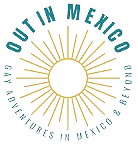

2 replies on “Gay-Friendly Oaxaca: Travel Guide for LGBTQ+ Visitors”
[…] THINGS TO DO & SEE IN OAXACA CITY […]
[…] THINGS TO DO & SEE IN OAXACA CITY […]